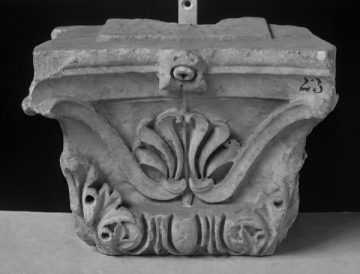Explore Collections


You are here:
CollectionsOnline
/
Roman capital from a rectangular pier or pilaster
Browse
Roman capital from a rectangular pier or pilaster
117-138 AD
Hadrianic
Hadrianic
Luna marble
Height: 24cm
Width: 33cm
Thickness: 22cm
Width: 33cm
Thickness: 22cm
Museum number: M23
On display: Museum Corridor - outside the Picture Room
All spaces are in No. 13 Lincoln's Inn Fields unless identified as in No. 12, Soane's first house.
For tours https://www.soane.org/your-visit
Curatorial note
This capital has egg and dart enrichment at the base, partly covered by acanthus leaves rising at each corner. Above, on the main face, double-curved scrolls descending from the outer corners of the abacus to meet above the egg and dart enrichment. A palmette motive springs from their junction while a central stalk leads to a rosette on the abacus.
This capital is definitely of a school of Hadrianic work that is found both in the Rome area (as the Tatham provenance shows that this piece was) and in Greece. There are many parallels in the store of the National Museum, Athens, recognisable from the technique used for the leaf detail, the egg and tongue, and the arrangement of enrichment. The Athenian work is a product of the Hadrianic rebuilding of that city and it remains to be decided: whether the carvers from Athens went to work in Italy; whether the Emperor imported stoneworkers from the capital to Greece, or whether the close identities of stylistic detail are the results of schools of craftsmen from a third, common source - Asia Minor, for example. Close stylistic parallels are also found in at least two Hadrianic deep pilaster capitals in the Olympia Museum, and D. Schlumberger1 has demonstrated that the numerous examples of acanthus cutting on Corinthian capitals in Syria, Palestine, and even Arabia, of the imperial period stem from a strong Hellenistic tradition modified by Augustan Vitruvianism and introduced through Antioch from the North.
While there are derivative parallels in Rome2, the absence of identical capitals or fragments in collections there and the presence of a number of similar pieces in the Casino Fede (the Antiquarium of the Villa Adriana [or Hadrian's Villa] at Tivoli, suggest that this capital also comes from the Villa Adriana where decorative carving was carried out by a school of craftsman who probably came from the Asia Minor coast and the north eastern end of the Mediterranean Sea proper.
Walker dates the three capitals e.g. this one and and two others in Soane's collection, Vermeule 65 (M22) and Vermeule 66 (M692), later than Vermeule had them at around 150 AD. She also comments that they have an 'elegance in design that is not typical of works in Greece in the Antonine period'.
1 D. Schlumberger, Syria, 1933. pp. 283-317.
2 Compare Acta Archaeologica (Copenhagen), VII, 1936, p. 230, no. 18 and bibliography.
This capital is definitely of a school of Hadrianic work that is found both in the Rome area (as the Tatham provenance shows that this piece was) and in Greece. There are many parallels in the store of the National Museum, Athens, recognisable from the technique used for the leaf detail, the egg and tongue, and the arrangement of enrichment. The Athenian work is a product of the Hadrianic rebuilding of that city and it remains to be decided: whether the carvers from Athens went to work in Italy; whether the Emperor imported stoneworkers from the capital to Greece, or whether the close identities of stylistic detail are the results of schools of craftsmen from a third, common source - Asia Minor, for example. Close stylistic parallels are also found in at least two Hadrianic deep pilaster capitals in the Olympia Museum, and D. Schlumberger1 has demonstrated that the numerous examples of acanthus cutting on Corinthian capitals in Syria, Palestine, and even Arabia, of the imperial period stem from a strong Hellenistic tradition modified by Augustan Vitruvianism and introduced through Antioch from the North.
While there are derivative parallels in Rome2, the absence of identical capitals or fragments in collections there and the presence of a number of similar pieces in the Casino Fede (the Antiquarium of the Villa Adriana [or Hadrian's Villa] at Tivoli, suggest that this capital also comes from the Villa Adriana where decorative carving was carried out by a school of craftsman who probably came from the Asia Minor coast and the north eastern end of the Mediterranean Sea proper.
Walker dates the three capitals e.g. this one and and two others in Soane's collection, Vermeule 65 (M22) and Vermeule 66 (M692), later than Vermeule had them at around 150 AD. She also comments that they have an 'elegance in design that is not typical of works in Greece in the Antonine period'.
1 D. Schlumberger, Syria, 1933. pp. 283-317.
2 Compare Acta Archaeologica (Copenhagen), VII, 1936, p. 230, no. 18 and bibliography.
Rome; collected in Rome by Charles Heathcote Tatham for the architect Henry Holland during the 1790s. See Cornelius Vermeule, unpublished catalogue of the Antiquities at Sir John Soane's Museum, Introduction, transcription of Tatham letters, List 1, no. 15.
Literature
Tatham: Etchings, 9; Drawings, 12.
Susanne Walker, 'Corinthian Capitals with Ringed Voids', Archäologischer Anzeiger, 1979, pp. 116-7, no. 7, fig. 14.
Susanne Walker, 'Corinthian Capitals with Ringed Voids', Archäologischer Anzeiger, 1979, pp. 116-7, no. 7, fig. 14.
Soane collections online is being continually updated. If you wish to find out more or if you have any further information about this object please contact us: worksofart@soane.org.uk


